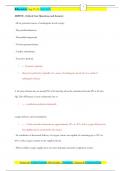Exam (elaborations)
ABSITE - Critical Care Questions and Answers
All are potential causes of cardiogenic shock except:
- Myocardial infarction.
- Pericardial tamponade.
- Tension pneumothorax.
- Cardiac arrhythmias.
- Excessive preload.
:-- Excessive preload.
(Excessive preload is typically not a cause of cardiogenic shock, but is a result of
ca...
[Show more]
Preview 4 out of 54 pages
Uploaded on
August 28, 2024
Number of pages
54
Written in
2024/2025
Type
Exam (elaborations)
Contains
Questions & answers
Institution
ABSITE
Course
ABSITE
$13.49
100% satisfaction guarantee
Immediately available after payment
Both online and in PDF
No strings attached
1




